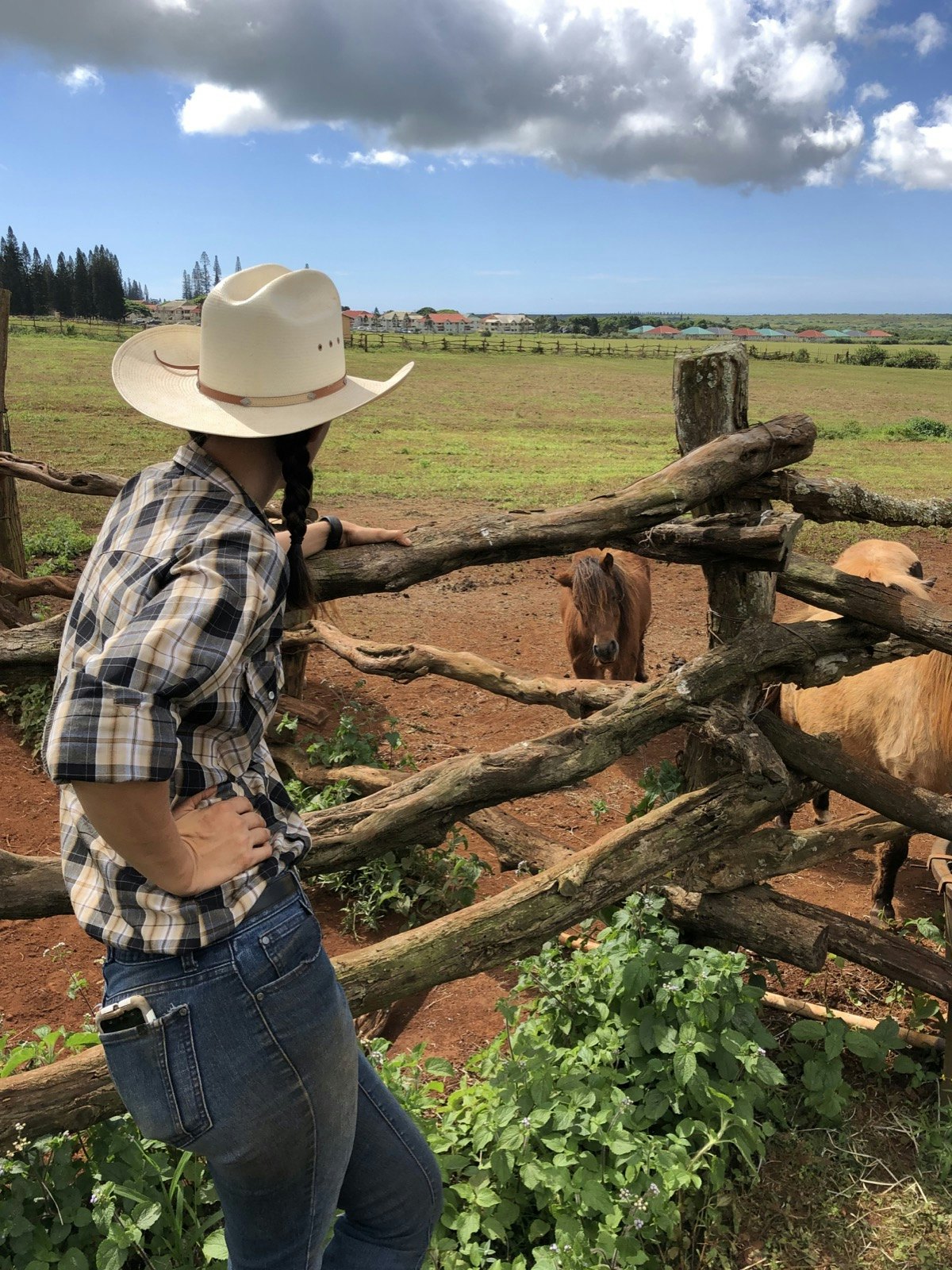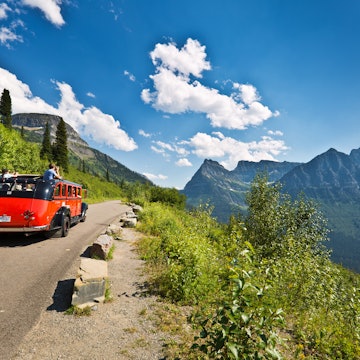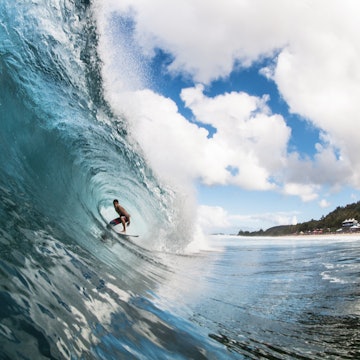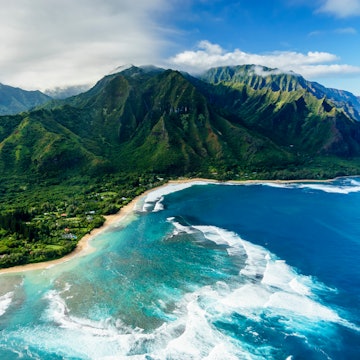
Historic Hawaii: exploring the stories of Moloka‘i and Lana‘i

Feb 18, 2019 • 11 min read

A view of the Milky Way from Moloka'i is a reminder of the island's many stories © Alexander Howard / Lonely Planet
Few places in Hawaii are as untouched as the sibling islands of Moloka'i and Lana‘i. Rare are the high-rises, shopping centers and shoulder-to-shoulder beaches of the other islands. Instead, visitors can hear the tales of the islands’ past.
A visit to either of these islands is a step into Hawaii’s history, whether it’s listening to tales of a great tsunami that changed a valley forever, descending into a land of exiles, or learning about the rich traditions of the islands’ cowboy culture.

Hike into an ancient valley
The sound from Greg Solatorio’s conch shell is a sustained, brassy note that trumpets through the emerald valley. In the distance, dogs bark in response. Traditionally, the sound was to announce the arrival of guests. ‘This is our “shell phone”,’ he says.
Greg is my guide on a hike through the Halawa Valley, an idyllic slice of earth on the eastern side of Moloka'i. At the end of the valley is a 250-foot, double-tiered waterfall with a swimmable pool below – ostensibly the reason for the hike. But it’s also a chance to meet Greg, who, dressed in a red kikepa draped over his body like a toga, is a wealth of knowledge about Hawaiian history and culture.
Greg’s family owns the land in the Halawa Valley, and the only way inside is to visit with their permission. Greg says his family has lived in the valley for generations, and he still lives the way his ancestors did – hunting for food and farming poi, a starchy root vegetable otherwise known as taro. ‘I live self-sufficiently because it was the way of my people,’ Greg says. ‘This is who I am.’

The valley was rich enough to support a village of 5,000 people until it was wiped out by a tsunami on April 1, 1946, Greg explains. His father, Anakala Pilipo Solatorio, was six years old at the time, and recounted the story to Greg. The night before, a phone call came in warning of the tsunami, but the valley's inhabitants only spoke Hawaiian and had no idea what the word meant. ‘They thought someone named “tsunami” was arriving tomorrow,’ Greg says.
The next day, the waves came, traveling more than a mile into the valley, uprooting taro farms and destroying homes. The villagers scurried to higher ground and everyone survived, but their way of life was sucked out of the valley by the tsunami’s powerful force. Afterward, all but a few families left the valley.
Today, it’s a quiet area of damp jungle, far away from the high-rises of Waikiki or the landscaped resorts on Maui. But it’s also rich with history and cultural importance, mostly thanks to Greg and his family’s continued commitment to keeping traditions alive. Greg picks up a lumpy green fruit from the mud. ‘This is noni,’ he says. ‘It’s used to treat all kinds of ailments. It reduces temperatures, prevents cancer, baldness. But it stinks.’ He waves it in front of my nose, and sure enough, it smells somewhere between a natural medicine shop and feet.

As we walk deeper into the valley, the outside world fades away. There’s no cell reception, and the sound of our footsteps and the wind in the trees replace whatever notification chimes I might expect. Water rushes over the rocks lining the bank of the river flowing toward the ocean at the mouth of the valley. The mosquitoes are out, but Greg shows us how to snap off a small branch and use it to wave them away.
We pass a wall of moss-covered rocks, remnants of an ancient Hawaiian village. No one is sure how long humans have lived in the Halawa Valley, but archaeological evidence suggests it has been populated since the middle of the seventh century A.D. ‘A lot of the ancient rock walls in the valley were used for farming terraces or marking pathways and temples,’ Greg says.

I can hear the waterfall before it appears between the trees, the soft roar filling the valley with sound. As I round a bend in the river, the top of the waterfall appears over the rocks. It’s a double-tiered cascade, with the higher falls barely peeking over the top of the lower falls. I take off my shoes, stumble over the rocks and wade into the cold water. In spite of the noise and wind, it’s a serene place.
The hike back is mostly in silence. We’re tired, and the sound of the waterfall still rings in our ears. I ask Greg why he’s chosen to stay in the valley.
‘This is my home,’ Greg says. ‘It’s my responsibility to make sure that people learn the right stories, to keep the stories and the legacy of the families of Halawa Valley alive.’
A beautiful prison
At the Kalaupapa Overlook, I peer over a wire fence. In the distance, 1,600 feet below, the village of Kalaupapa looks like any other small Hawaiian town: a cluster of tiny buildings encircled by green forest and frothy coastline. A white church stands in the center of town, with a lighthouse and airport a mile and a half away. Coconut trees dot the earth like tiny, upright paint brushes.

From above, the view is quaint and pleasant, a paradise just out of reach, but the view belies the fact that Kalaupapa was a land of exiles for almost a century.
When the first Europeans came to the Hawaiian islands, they brought diseases that devastated the local people. ‘Two-thirds of the Hawaiian population were wiped out in the span of 100 years,’ Clare Mawae says. Clare is my guide into Kalaupapa, now a national park, and she tells me about the place’s history as we descend a rocky path.
At the time, the cause of leprosy was not well understood, and isolating affected people was a common tactic against the affliction. In 1865, the king signed into law an act banishing all victims of leprosy on Hawaii to this remote corner of Moloka'i. Embraced by some of the tallest sea cliffs in the world, the Kalaupapa peninsula was chosen for its isolation, and even today no roads connect the community to the rest of the island. The only way into Kalaupapa by land is via a 3-mile mule trail.

At first, the colony was just a dozen people, but over the course of the following century 8,000 people – from Hawaii and abroad – would be sent to the colony.
Eventually, the steep trail evens out onto the coast just south of the main town. Clare and I board a waiting bus and head through the village. Clapboard homes and tended lawns swing by against the backdrop of sea cliffs. The homes today are mostly the residences of the few dozen healthcare professionals and people who manage the national park. A breeze rustles the trees in the yards.
In 1873, a Belgian priest named Father Damien de Veuster arrived at the settlement and became a sort of champion of the colony. He helped build schools, roads, houses, a water system and churches.

We head east to Kalawao, the site of the original settlement and enter St. Philomena Catholic Church, a church Father Damien helped expand. Inside, stained glass windows color the walls, the high cliffs visible in the daylight outside. Pictures of Christ’s crucifixion and resurrection are hung between each window.
Outside, a small graveyard contains the remains of past residents. The largest tombstone, encircled by an iron gate that’s wreathed in lei and flowers, marks Father Damien’s original grave. Although the disease isn’t highly contagious, Damien’s repeated proximity with his patients meant contraction was all but guaranteed. He bandaged wounds and shared his pipe. He ate from the same bowls of poi as his patients and played with diseased children. The very method by which he helped build the community, by coming in close contact with the people the world had banished, ultimately led to his death. In 2009, he was canonized by the Catholic Church.
We eat lunch at a picnic table overlooking the eastern coast of the peninsula. Above us, slender coconut palms sway in the breeze. Clare says she always returns having gained a new perspective after a trip to Kalaupapa. ‘When I come down, I re-ground myself. I ask, “Why did I complain about that?”’

As advancements in medicine led to a cure for leprosy, the period of mandatory isolation ended in 1969, and patients were allowed to leave. But a few chose to remain, including several who still live on the peninsula.
To the east, the cliffs continue along the coast like tall sentries standing guard, but their captives are no longer here. The view is quiet and beautiful – not so much a prison, but a home.
Editor’s note: On December 25, 2018, a landslide destroyed part of the trail leading into Kalaupapa, closing the trail down indefinitely.
The layers of Lana‘i
On the nearby island of Lana‘i, I check into the Four Seasons, the only hotel currently open. Huge, open doorways frame the resort’s private beach and lushly landscaped pool area. The luxurious resort’s construction is the latest phase in the island’s otherwise tumultuous history – at one point or another it has been a protectorate of nearby Maui, a Mormon colony, a gigantic ranch and the world’s largest pineapple plantation. In 2012, tech billionaire Larry Ellison purchased 98 percent of the island and began converting it into a luxury travel destination, the Four Seasons being the most visible example of the latest changes.

After check-in I head over to the Stables at Koele, which offers horseback riding tours through the pine-covered hills that form the undulating center of the island. There I meet Grace Fritz, a mainlander from Kansas dressed in a western hat and plaid shirt. I also meet my horse, Zip, a cinnamon-colored mare that eyes me warily.
In 1793, Captain George Vancouver brought a gift of six cows and a bull to King Kamehameha I, and released them on the Big Island. That first herd didn’t fare too well, falling victim to disease and hungry locals, so the king placed a kapu, or Hawaiian taboo, on hunting the cattle. The population of cows grew into a feral herd that ransacked local crops and in a few cases hurt and killed people.
The kapu was lifted in 1830, but by then tens of thousands of wild cattle roamed the island. To handle the hooved menace, King Kamehameha III brought three Mexican vaqueros (cowboys) to the island to help train Hawaiians to manage the cattle. The vaqueros introduced horseback riding and herding techniques to the islanders, who called the foreign cowboys paniolo, a corruption of ‘español’, which the vaqueros spoke.

After the vaqueros left, paniolo culture continued to develop in Hawaii – mainly on the Big Island, but throughout the other islands too.
Eventually, cattle were brought to Lana‘i. ‘There was a huge ranch out here,’ Grace says as we plod across a hillside. ‘The whole island was a ranch, with cattle, goats and sheep, for a while.’ Indeed, the pasture looks perfect for grazing – open plains covered in short grass, with trails of red dirt winding through.
I spot something fluttering in the dirt and see what looks like ragged plastic buried shallowly in the soil. It’s everywhere, striating the earth like the remnants of some ancient artifact. I ask Grace what it is. ‘It’s plastic from the pineapple plantation,’ Grace says. After its stint as a cattle ranch, the island was purchased by the Dole Hawaiian Pineapple Company, and the company began planting what would become the world’s largest pineapple plantation, estimated between 15,000 and 20,000 acres. The plantation lasted for almost 70 years until Dole moved its pineapple operations to Central and South America, beginning the modern history of Lana‘i as a travel destination.
We ride through a forest of ironwood, Zip’s hooves clip-clopping behind Grace and her own brown mare. The forest opens at an overlook, and the wide expanse of Lana‘i unravels before us, the Pacific beyond.

On my final day in Hawaii, I take a Jeep out to the northeast side of the island, where I’m told an old backcountry trail has more artifacts of early Lana‘i. I park the Jeep at a beach pullout and hike a mile inland, following a rudimentary system of cairns to a series of petroglyphs. The images are of humans and animals scratched into the red rock. The figures’ triangular-shaped bodies are plain but easily discernible. As I return to the car, I spot the rusted hulk of a shipwreck run aground a few hundred yards offshore. A nearby sign explains it’s the scuttled remnants of a WWII-era ship, the YOGN-42.
The pairing – aged petroglyphs next to a rusted hulk of warm – seems a perfect symbol of Lana‘i itself and Hawaii at large: the ancient beside the modern, with the layers of human stories in between.
Alexander Howard traveled to Hawaii with support from the Maui Visitors & Convention Bureau. Lonely Planet contributors do not accept freebies in exchange for positive coverage.
https://shop.lonelyplanet.com/products/maui-travel-guide-4?via=Z2lkOi8vbG9uZWx5LXBsYW5ldC9Xb3JrYXJlYTo6Q2F0YWxvZzo6Q2F0ZWdvcnkvNTllZTQ5YmRmOTJlYTE0MTg2MDU4Njg2















